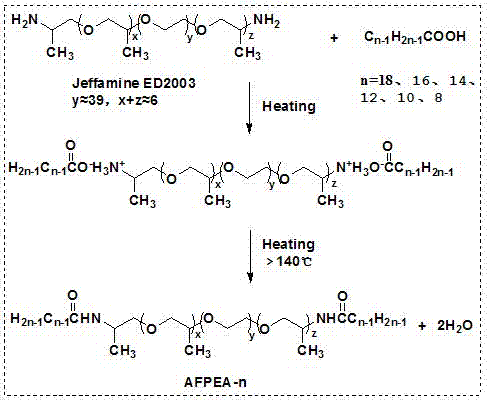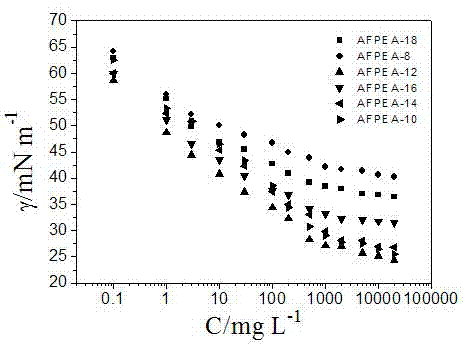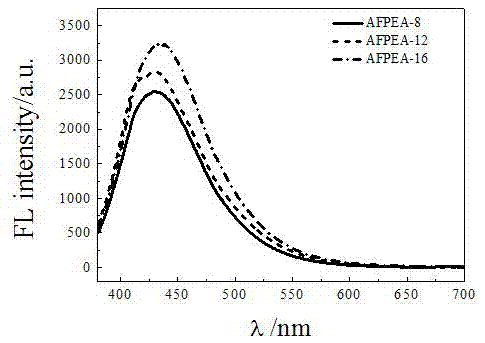Amphipathic AIE (aggregation-induced emission) molecule, synthetic method thereof, autofluorescence nano-micelle and application
A technology of aggregation-induced luminescence and synthesis method, which is applied in the field of autofluorescent nanomicelles, can solve the problems of rarely researched and reported amphiphilic AIE molecules, etc., and achieves the effect of easy purification and simple process
- Summary
- Abstract
- Description
- Claims
- Application Information
AI Technical Summary
Problems solved by technology
Method used
Image
Examples
preparation example Construction
[0030] A method for synthesizing amphiphilic light-emitting molecules with aggregation-induced light-emitting characteristics of the present invention comprises the following steps: under a nitrogen atmosphere, heat and reflux polyetheramine as a reaction initiator and a grafting agent to obtain a brown Liquid product, the product is cooled to room temperature, washed with an organic solvent, filtered, and dried. The final product is brown waxy solid or syrup.
[0031] A method for synthesizing amphiphilic light-emitting molecules with aggregation-induced light-emitting properties of the present invention, wherein the structural formula of the reaction initiator polyetheramine is:
[0032] or ;
[0033]Wherein, X and Z are integers from 0 to 100, and Y is an integer from 5 to 500.
[0034] The invention relates to a method for synthesizing amphiphilic light-emitting molecules with aggregation-induced light-emitting properties, wherein the grafting agent is any one of carb...
Embodiment 1
[0045] Example 1: Synthesis of AFPEA-18 Luminescent Molecules
[0046] Synthesis method: Weigh a certain amount of JeffamineED2003 and stearic acid into a 50mL three-necked round bottom flask, the molar ratio of JeffamineED2003 to stearic acid is 1:2~1:2.2. Under the protection of nitrogen, heat to 160-200°C with magnetic stirring, react for 4-8 hours (detect the reaction time by TLC), stop heating, and obtain a brown liquid product. After the product was cooled to room temperature, it was washed with petroleum ether, filtered, and dried. The final product was a brown waxy solid. use 1 The structure of the product was characterized by HNMR, which confirmed that the product was compound AFPEA-18. 1 HNMR (500MHz, CDCl 3 )δ0.83(t,6H,J=5.6Hz),1.04~1.12(m,21H),1.20~1.23(m,56H),1.56(m,4H),2.09(t,4H,J=6.12Hz ), 3.59(m,170H).
Embodiment 2
[0047] Example 2: Synthesis of AFPEA-16 Luminescent Molecules
[0048] Synthetic method: similar to the synthetic method of Example 1, the difference is that the grafting agent is palmitic acid, and the product is a brown waxy solid. use 1 The structure of the product was characterized by HNMR, which confirmed that the product was compound AFPEA-16. 1 HNMR (500MHz, CDCl 3 )δ0.88(t,6H,J=6.75Hz),1.09~1.18(m,21H),1.25~1.28(m,48H),1.61(m,4H),2.14(t,4H,J=8.45Hz ),3.60~3.69(m,170H).
PUM
| Property | Measurement | Unit |
|---|---|---|
| The average diameter | aaaaa | aaaaa |
Abstract
Description
Claims
Application Information
 Login to View More
Login to View More - R&D
- Intellectual Property
- Life Sciences
- Materials
- Tech Scout
- Unparalleled Data Quality
- Higher Quality Content
- 60% Fewer Hallucinations
Browse by: Latest US Patents, China's latest patents, Technical Efficacy Thesaurus, Application Domain, Technology Topic, Popular Technical Reports.
© 2025 PatSnap. All rights reserved.Legal|Privacy policy|Modern Slavery Act Transparency Statement|Sitemap|About US| Contact US: help@patsnap.com



